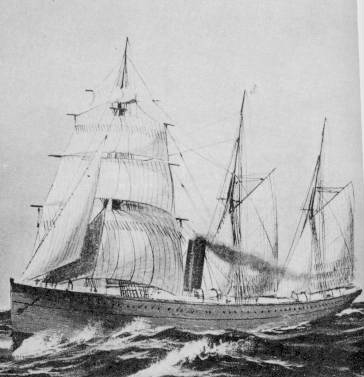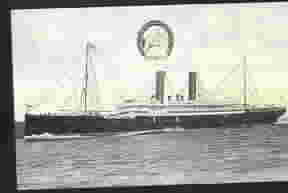
Italia, Anchor Line, taken
by my Great-grandfather from Italy
Paying for the voyage
At the turn of the century, the price of the lowest
priced sterrage tickets were $25-35 depending on the port of embarkation. Since the price
of a ticket was often too expensive for the poor people remaining in Europe, it was often
sent back from the earlier arrivals to America. One ticket was equivalent to 2 or 3 weeks
wages and after room and board an immigrant might have 50/week to save.
Many emigrants travelled with someone from their town. The
support of people they knew was critical during the voyage and upon arrival.
Routes from Italy
Naples - Sicily - New York
Southern Italy, the source of most Italian immigrants had
two major departure points Naples and Sicily. People traveled from as far as Sicily to
depart on voyages from Naples. St. Angelo dei Lombardi and San Costantino Albanese are inland towns whose residents went
overland to Naples to go to America
Traveling out of rural areas to the port towns was
difficult since there were no cars and train service was only between major cities. Some
people came into the port towns on smaller boats for the transfer to major steam lines for
the oceanic voyage.
Routes from Ireland
Glasgow - Londonderry - New York
A couple of major points served as embarkation
points reached overland by emigrants. Cavan county is the most
southern county of Ulster of which Londonderry (in Northern Ulster) was the major Irish
port. Trains were not extensive in Ireland so people reached port cities by foot, horse,
and later car.
Routes from Poland
Gdansk - Hamburg - New York
Trains from major towns in the interior of Poland went
north to the port city of Gdansk or Danzig.
In addition to the steamship ticket, the trip required
assembling a large number of papers to be delivered to the American consulate in Warsaw.
Included were medical certificates, birth records, police records, statements from parents
if a minor, statements from local authorities proving lack of debts.
The consul sent an appointment and as long as you had a
affidavit from a close relative in the US proving that you wouldn't be a public charge, a
visa was issued for travel.

Emigrants on deck en route to America
Ships Manifest
The ships manifest kept track of all the
people on board and was the record keeping tool for arrival in the United States. The
manifest noted medical examinations if they took place before departure and had
information about every passenger on board. Shipping companies prepared the lists abroad,
rechecked at departure, and the lists were checked again upon arriving in the U.S.
The information was usually by class
starting with the first and second which were typically very small (under 30 poeple) on
these voyages and usually made up exclusively of Americans. The bulk of the manifest
covered the steerage class and became more detailed during the peak immigration years
after 1900. The steerage class could be as many as one thousand people on ships such as
the Kaiser Wilhelm II. Steerage is the below the waterline area named for its proximity to
the steering mechanism.
The following is information from the ships
manifest on the Italia arriving Apr. 20, 1909 from Naples.
Pasquale Pomarico, line 8
- Listed as traveling for the first time, this was apparently
not the first trip over since census records indicate that he came over first in 1892, 15
years earlier. Two children were born in Italy during that time indicating voyages back
and forth. These people were called "birds of passage" and typically arrived in
the spring and returned to Southern Europe by Christmas.
- Pasquale listed Francesco Pomarico, his uncle, living at 494 President in Brooklyn as his contact person.
Luigi Pomarico, line 12
- Luigi listed a different person, Donato Pomarico, as his
contact person. However, Donato was living with Francesco and family at 494 President at
the time. In 1898, Donato had used his brother Pasquale as his contact person.
Maddalene DiPiacere, line 7
- Miss DiPiacere was traveling from the same hometown as
Pasquale and his cousin Luigi. Unlike them, she was headed to Waterbury, CT with a
companion. The companion was from Torella dei Lombardi, a town near S. Angelo and the
birthplace of Pasquale, along with a very large group of people on the boat.
DiPiacere’s trip might have been one reason for Pasquale taking this particular
voyage. Based on other manifests, Waterbury was a popular destination for people from the
Sant Angelo dei Lombardi area. After 3 years in New York, Luigi appears in the directory
for Waterbury where he stayed for one year.
Steamship Lines
Before 1880, sailing ships still made the long trip across
but they took as long as 1-3 months to make the trip. Steam powered ships took over by
later making the trip in 8-14 days.
Several major steamboat lines such as Cunard and White Star plied the
North Atlantic during the peak years of this migration. The steerage class, taken by poor
travelers, was a money maker for the lines and additional boats were commissioned to
increase revenues along the route. The boats were steam powered and sometimes supplemented
by sails.

S.S. California taken by
another relative
The North Atlantic during the winter can be a treacherous
route as discovered by the Titantic. Steamship traffic increased in the summer months
although many of our ancestors arrived as late as early December. The voyage took
approximately 10 days from Italy.
 Conditions Conditions
While far better than the slave ships of the same period,
the paid voyage was not an easy one. 10-15% of the people often died during the
voyage early in the 1800s. In 1819, the federal government tried to regulate the shipping
lines setting passenger limits, minimums of water and provisions and fined offenders.
Unfortunately, this law did not cover passengers in steerage.
Steerage passengers were required to carry their own food
for the voyage. Only after 1848 was cooked food required for steerage passengers as well.
The amount of time locked in the airless below deck area meant high exposure to contagious
diseases. With the change to steam powered ships later in the 1800s, the shorter transit
time meant reduced exposure to such contagions although the conditions were often little
improved. |